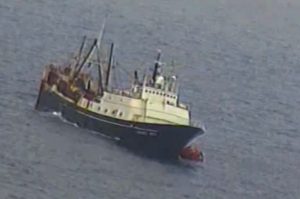Coast Guard Continues Investigation of Alaska Juris Sinking
 Two weeks of Coast Guard hearings and testimonies this past month are slowly revealing the mystery behind the July 26th sinking of the Alaska JURIS that forced 46 crewmembers to abandon ship in the Bering Sea. Chief Engineer aboard the JURIS, Eddie Hernandez, was a key witness for Coast Guard attempts to reveal operations of the vessel’s owner, Fishing Company of Alaska. The company teams with a Japanese fish buyer, Anyo Fisheries, and continues to operate three factory trawlers whose crews process and freeze catch.
Two weeks of Coast Guard hearings and testimonies this past month are slowly revealing the mystery behind the July 26th sinking of the Alaska JURIS that forced 46 crewmembers to abandon ship in the Bering Sea. Chief Engineer aboard the JURIS, Eddie Hernandez, was a key witness for Coast Guard attempts to reveal operations of the vessel’s owner, Fishing Company of Alaska. The company teams with a Japanese fish buyer, Anyo Fisheries, and continues to operate three factory trawlers whose crews process and freeze catch.
This is not the first time that Fishing Company of Alaska has been at the center of a major Coast Guard inquiry. In fact, many issues that surfaced during the Alaska JURIS hearings paralleled the 2008 sinking of FCA’s Alaska Ranger. In both instances, there were reported gaps in a Coast Guard inspection program, chronic vessel maintenance issues, and safety conflicts between a U.S. crew and Japanese workers.
Although the report on the Alaska JURIS is not expected for months, the hearings offered a look at conditions and operations aboard the vessel. Crewmember Carl Lee Jones revealed in testimony problems surrounding rusting pipes, run down crew quarters, and Japanese crew members who refused to participate in safety drills.
According to lead investigator, Cmdr. Michael DeLury, the leak that sunk the JURIS likely resulted from a failure of the piping that brings in seawater for tasks such as engine cooling. The leak otherwise could have originated from a burst pipe or failure of a water filtering system. Crew aboard the JURIS attempted to deploy emergency pumps, though these systems were worn out, improperly positioned, and extremely difficult to operate. A series of mishaps, failed bilge alarms, and lack of a viable pumping system likely contributed to the outcome. Though the vessel was insured for $4.3 million, that number is far below what a replacement ship would cost.
Testimonies from Fishing Company of Alaska officials also revealed the extensive history of the vessel. The Alaska JURIS captain, Paul Jopling, noted that the Juris was on the upswing after issues with crewmembers who violated policies, poor ventilation, and serious maintenance problems. Just eight days before the boat went down, Jopling wrote an email to FCA citing a necessary repair at the next port stop, “if we can hang on that long.” The item was a 30-foot section of rotted out pipe that carried seawater into the vessel.
Although Japanese crews were forbidden under maritime law from assuming command of the vessel, both Hernandez and Jopling were at odds with Japanese fishmasters. Conflicts such as safety issues, assaults, and unstable crew dynamics were acknowledged in hearings.
Because Anyo Fisheries purchases 100% of the vessels’ product, they expect to bear a portion of responsibility for maintenance problems in the fleet. The final report will detail the role of Anyo’s Japanese crew, as well as shortcomings of the Coast Guard safety program.
 Maritime Injury Law Blog
Maritime Injury Law Blog

